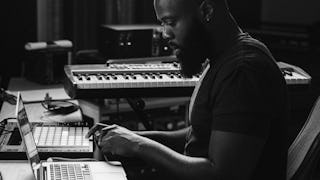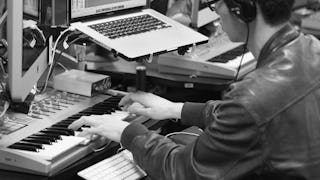From the Moog analog synthesizers in the 1960s to the contemporary usage of computers, performance controllers, and mobile devices, Electronic Digital Instruments (EDIs) have long been capable of offering artists a new range of musical expression. In this one-of-a-kind course, you’ll learn the essential skills you need to perform on an EDI.

Enjoy unlimited growth with a year of Coursera Plus for $199 (regularly $399). Save now.

Electronic Music Performance Techniques
This course is part of Electronic Music Production Specialization

Instructor: Rishabh Rajan
8,410 already enrolled
Included with
(29 reviews)
Recommended experience
Skills you'll gain
Details to know

Add to your LinkedIn profile
See how employees at top companies are mastering in-demand skills

Build your subject-matter expertise
- Learn new concepts from industry experts
- Gain a foundational understanding of a subject or tool
- Develop job-relevant skills with hands-on projects
- Earn a shareable career certificate

There are 4 modules in this course
Welcome to the course! Here we will cover all the details about the course and what you'll need to know to get the most out of your experience. Then, we will practice several basic drum patterns as well as look at how to create more complex drum tracks for your original songs. We will also discuss how you can program a song into your EDI to discover new ideas. Finally, we will learn how to live loop drum patterns using Ableton Live.
What's included
9 videos6 readings2 assignments2 discussion prompts
In this second lesson, we will look at how to play harmonic accompaniment on the EDI. We will play through several basic chord progressions and learn to play extended chords such as 7th's and 9th's. Finally, we will practice recording and looping harmonic parts.
What's included
6 videos1 reading2 assignments1 discussion prompt
Now that we have learned some basics on the EDI, it is time to start building a composition. In this lesson we will discuss how to develop an interesting bass line as well as how to improvise melodies using the Minor Blues Scale. By the end of the lesson, you will be able to create your own bass line for your original composition and practice improvising melodies on top of it.
What's included
4 videos2 assignments1 discussion prompt
In this lesson we will put together everything we have learned so far to create an arrangement to perform in front of an audience. We will discuss how to create our own sounds on Ableton and we will practice creating arrangements that build and entertain our audience. By the end of this lesson, you will be able to perform your own arrangement.
What's included
6 videos1 reading1 assignment1 peer review
Earn a career certificate
Add this credential to your LinkedIn profile, resume, or CV. Share it on social media and in your performance review.
Instructor

Offered by
Explore more from Music and Art
 Status: Free Trial
Status: Free TrialBerklee
 Status: Free Trial
Status: Free TrialBerklee
 Status: Free Trial
Status: Free Trial Status: Preview
Status: Preview
Why people choose Coursera for their career




Learner reviews
29 reviews
- 5 stars
62.06%
- 4 stars
13.79%
- 3 stars
10.34%
- 2 stars
6.89%
- 1 star
6.89%
Showing 3 of 29
Reviewed on May 5, 2023
grate and clearly explain your skill gonna be developd.
Reviewed on Sep 2, 2020
Great course to move onto once Ableton Live fundamentals are known

Open new doors with Coursera Plus
Unlimited access to 10,000+ world-class courses, hands-on projects, and job-ready certificate programs - all included in your subscription
Advance your career with an online degree
Earn a degree from world-class universities - 100% online
Join over 3,400 global companies that choose Coursera for Business
Upskill your employees to excel in the digital economy
Frequently asked questions
To access the course materials, assignments and to earn a Certificate, you will need to purchase the Certificate experience when you enroll in a course. You can try a Free Trial instead, or apply for Financial Aid. The course may offer 'Full Course, No Certificate' instead. This option lets you see all course materials, submit required assessments, and get a final grade. This also means that you will not be able to purchase a Certificate experience.
When you enroll in the course, you get access to all of the courses in the Specialization, and you earn a certificate when you complete the work. Your electronic Certificate will be added to your Accomplishments page - from there, you can print your Certificate or add it to your LinkedIn profile.
Yes. In select learning programs, you can apply for financial aid or a scholarship if you can’t afford the enrollment fee. If fin aid or scholarship is available for your learning program selection, you’ll find a link to apply on the description page.
More questions
Financial aid available,
¹ Some assignments in this course are AI-graded. For these assignments, your data will be used in accordance with Coursera's Privacy Notice.

